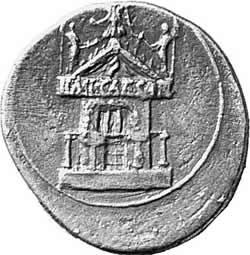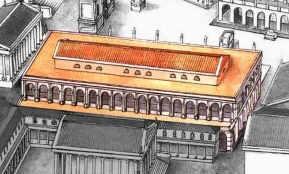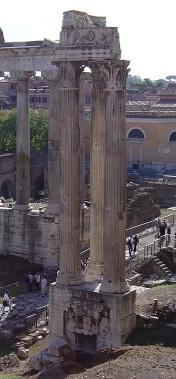|
|
 |
|
The Roman Forum |
|
written
by justinvf / 09.14.2005 |
|
|
| |
Description |
| |
| |

|
|
| Curia Julia |
| Though well preserved, this coin shows that the original building had 3 statues on top. |
| |
|
| |

|
|
| Basilica Julia |
| Though little remains, this picture gives an idea of the grand size of the original structure. |
| |
|
| |

|
| http://www.vroma.org/~bmcmanus/divi-caesaris1.jpg |
| Temple of the Divine Julius |
| Little remains of this politically significant building. |
| |
|
| |

|
|
| Temple of Vespasian and Titus |
| The three columns in the foreground were part of the temple. |
| |
|
Post-Imperial:
Curia
This was the senate house, moved to its current location by Julius Caesar. It is interesting to consider the message sent by Julius moving the position of the senate house to make way for his massive building projects. Within the curia, the three-hundred senators met for their formal meetings, with the president of the senate sitting in the back of the room.
The Curia is so well preserved due to its conversion to the Church of Saint Adriano. This conversion is responsible for the remarkable shape it is in now, just as many other buildings survived by being turned into churches. The church, as we will see, was responsible for much of the preservation, but also destruction, of the Forum.
Basilica Julia
A basilica in Roman times was an economic and judicial center, built for oratory and protection from the elements. This basilica would likely have had wooden removable barriers so that more cases could be heard at one time. If one looks at the steps of the Basilica, there are still the remains of game boards carved into the marble, evidence that the Basilica was very much a public space.
This is one of the many public works Caesar had built, which put him into an enormous amount of debt. The payoff for these expenditures was substantial though, such that upon his self appointment to dictator for life there was little opposition from the lower classes, to whom Caesar was a hero. The tradition of massive expenditures to win over the population via building projects started with Caesar, and was continued by most of the later emperors.
Tempe of the Divine Julius
To understand the significance of the temple, the Roman climate around the time of its construction needs to be considered. The beginnings of the rift that was to cause the rise of an empire can be traced back to the feuds between the Optimates and the Populates. These two groups can be put roughly into the category of conservatives and populists, one wanting supremacy of the senate and headed by Sulla, the Optimates, and one wanting more involvement of the people and headed by Marius, the Populates. This rift was brought to the brink of violence when Sulla threatened to march on Rome, resulting in him being proclaimed dictator for ten years, a position normally given only in times of emergency for a six month period. Furthering the discord of the period was Spartacus’ slave rebellion, which was put down by Crassus. Crassus, a Populate, along with Pompey, a protégé of Sulla, were co-consuls and potentially set to erupt into another feud such of that of Marius and Sulla. They were instead brought into an alliance though by Julius Caesar, who was running for Consulship and agreed to fight for their political views in exchange for their support. Caesar was easily elected consul, and upon the end of his term, helped Crassus and Pompey again obtain the consulship. The alliance of tree, known as the First Triumvirate, fell apart however with the death of Marius and the Optimates pushing Pompey to try and impeach Caesar. As a result, when Caesar tried to return to Rome after his military campaign in Gaul a civil war erupted, which Pompey decisively lost. After this victory, Caesar returned to Rome and granted himself dictator for one year, ten years, and finally for life. Though Caesar had the large-scale support of the population in these actions, he understandably angered too many senators in and was subsequently assassinated. This vacuum sent Rome into a violent power struggle from which Augustus emerged on top after numerous political twists and backstabs. Augustus gave his powers back to the senate, but the senate returned those power (or was maybe forced to), and thus Augustus became the first emperor of Rome.
After all those tumultuous years during which Roman government shifted from a republic to an empire, Augustus had to establish his legitimacy to the people. The most important symbol of this was the Temple of Divine Julius. In a completely unprecedented action, Augustus had Caesar deified, something which had never been done in Rome save for the myth of Romulus. This practice of deifying politicians in order to legitimate one’s line is a practice later repeated many times, and its effectiveness should not be underestimated.
Temple of Vespasian and Titus
This was another deification temple built by Domitian to honor his brother Titus and father Vespasius. Vespasius came to rule after the two terribly unpopular emperors Nero and Caligula, which was then followed by the chaotic “Year of Four Emperors”. This time of great chaos was finally brought to order by Vespasius. After that fiasco Romans would plausibly be having great doubts in the effectiveness of the rule by emperor, so again we see this deification ritual as a way to reestablish the legitimacy of the system after a time of great chaos.
|
| |
|
| |
|
|
 |
|




